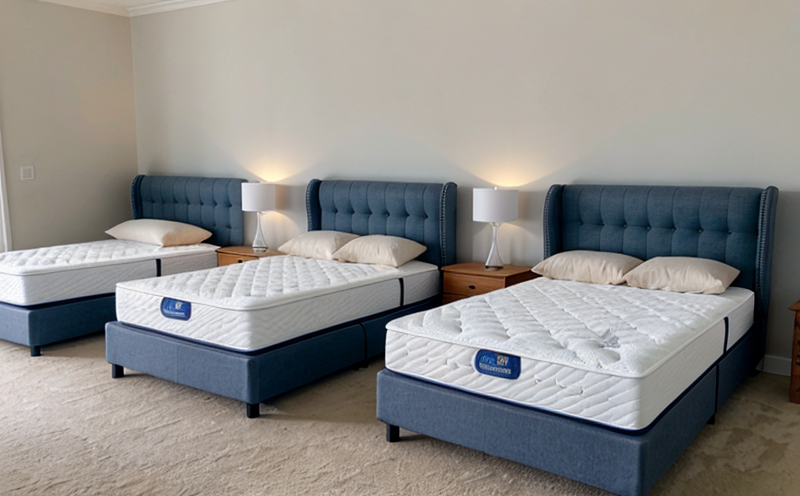DIN 54324 Mattress Foams Indentation Load Deflection Testing
The DIN 54324 test method is a standardized approach used to evaluate the indentation load deflection (ILD) properties of mattress foams. This testing procedure measures how much a foam compresses under a specified weight and records the resulting deflection depth, providing valuable insights into the resilience and comfort levels of mattresses.
This test is critical for manufacturers aiming to ensure consistent quality across their products while meeting regulatory requirements and customer expectations. The ILD value indicates the balance between firmness and comfort in mattress foams, making it a key metric in product development and quality assurance processes.
In this procedure, foam samples are compressed by a specified weight until they reach a defined depth. The deflection is measured accurately using precision instruments. The result is typically expressed as pounds per square inch (psi) or kilopascals (kPa). This standardized testing ensures that all manufacturers can compare their products fairly and consistently.
The DIN 54324 test method is widely used in the mattress manufacturing industry to ensure product quality, compliance with standards, and customer satisfaction. It provides a reliable means of assessing how foam behaves under different loads, which is crucial for both consumer comfort and durability considerations.
Understanding the ILD value helps manufacturers optimize their foam formulations and design more comfortable mattresses that meet market demands. By adhering to this standard, companies can enhance brand reputation through consistent product quality and performance.
Affected Industries
The DIN 54324 test is particularly relevant for furniture manufacturing sectors, especially those focused on beds and mattresses. This includes large-scale manufacturers as well as smaller artisanal workshops that prioritize high-quality products. Compliance with this standard ensures that all participants in the mattress market can produce consistent and reliable products.
Testing Procedure
The test begins by preparing a foam sample according to the specified dimensions outlined in DIN 54324. The sample is then placed on an indentation machine equipped with the necessary fixtures for accurate measurement. A calibrated weight is applied gradually until it reaches the predetermined depth, and the deflection is recorded.
Several factors must be considered during specimen preparation:
- Sample size: Typically, a rectangular slice of foam measuring 250 mm x 150 mm x 38 mm is used.
- Edge effects: Samples should be cut with smooth edges to minimize interference with the test results.
- Moisture content: Ensuring the sample has a consistent moisture level prevents discrepancies in the testing results.
The indentation machine must be calibrated regularly to ensure accurate measurements. The deflection depth is crucial for determining the ILD value, which is calculated using the formula:
ILD = (Load / Area) x 1000
This calculation provides a clear indication of the foam's firmness and resilience. A higher ILD indicates firmer foam, while lower values suggest softer materials.
Importance in Quality Assurance
The DIN 54324 test is essential for quality assurance departments as it helps identify any inconsistencies or defects within mattress foams early in the production process. By incorporating this standard into their testing protocols, manufacturers can prevent substandard products from reaching the market and enhance overall product reliability.
Applied Standards
| Standard | Title | Year |
|---|---|---|
| DIN 54324-1 | Indentation load deflection of foams for use in beds and mattresses - Part 1: Test method | 2018 |
| DIN 54324-2 | Indentation load deflection of foams for use in beds and mattresses - Part 2: Determination of the indentation modulus | 2019 |
The DIN 54324 standard is part of a broader series that addresses various aspects of foam used in bedding products. These standards provide comprehensive guidance on testing methods and parameters, ensuring consistency across industries.
Customer Impact and Satisfaction
The DIN 54324 test method plays a significant role in enhancing customer satisfaction by ensuring that mattresses offer the desired level of comfort. Consumers are increasingly aware of ILD values when choosing mattress products, making it essential for manufacturers to comply with this standard.
By adhering to DIN 54324, companies can:
- Ensure consistent product quality across batches and production runs.
- Demonstrate compliance with industry standards and regulations.
- Compete effectively in the marketplace by offering products that meet or exceed customer expectations.
In addition to improving brand reputation, adherence to this standard can lead to increased sales and loyalty among customers who value high-quality bedding. For instance, many consumers are willing to pay a premium for mattresses that have been rigorously tested according to recognized standards like DIN 54324.
Use Cases and Application Examples
- Benchmarking: Manufacturers use the results from DIN 54324 tests to benchmark their products against competitors.
- Purchasing Decisions: Retailers rely on ILD values provided by suppliers to make informed purchasing decisions and ensure product quality.
- R&D: Research and development teams use the test results to refine foam formulations and improve mattress designs for enhanced comfort and support.
- Regulatory Compliance: Compliance officers verify that all products meet regulatory requirements, ensuring safe and high-quality mattresses reach consumers.
The DIN 54324 test is not just a technical requirement but also a valuable tool for enhancing the overall customer experience. By incorporating this standard into their processes, manufacturers can offer products that consistently meet or exceed industry expectations, thereby fostering long-term relationships with satisfied customers.





